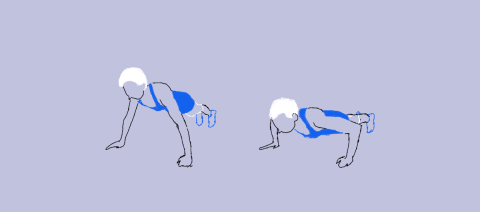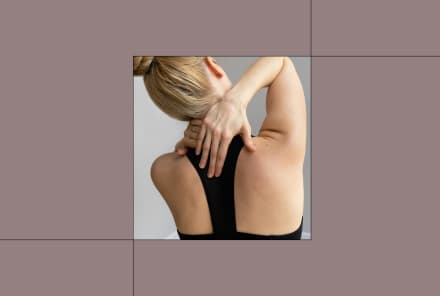Advertisement
6 Benefits Of Pushups + How Often To Do Them To See Results

When you think about pushups, what comes to mind? Maybe it's that challenging bootcamp class you barely survived. Or the drill-sergeant-like soccer coach you had in high school who frequently barked "Drop and give me 20!"
Health benefits of pushups.
Here are five reasons you should be doing pushups a few times a week:
Improved upper-body strength
It's no shocker that pushups seriously challenge your upper half. You are, after all, bending your arms to lower and lift your entire body.
"Pushups are a great upper-body strengthener," says Stephanie Mansour, Chicago-based certified personal trainer. That's because they work essentially your entire upper half, including the front of your chest, both the front and back of your arms (aka biceps and triceps), shoulders, and upper back, she explains.
Building strength in these areas will make certain day-to-day activities—like carrying a hefty bag of groceries, or lifting a suitcase into an overhead bin—feel a little easier.
Summary
Improved core strength and stability
But pushups aren't just about upper-body strength. They "can be a full-body workout if done correctly," says Shaun Zetlin, Brooklyn, New York-based Certified Strength and Conditioning Specialist. He says that they can also work your core and the muscles in your midsection—including lesser-worked ones like the transverse abdominis (the deepest core muscle that helps supports your spine) and multifidus (a series of small muscles that run along the spine).
Summary
They can double as cardio
In certain scenarios, pushups can also double as cardio, says Zetlin. If you do enough pushups, your heart will likely start to pump faster, and you may feel out of breath.
Depending on your fitness level, you may not need to bust out a bunch of reps to get to this point. A set of 10 pushups, for example, may be enough.
Summary
They support cardiovascular health.
Pushps may support heart health, too, according to a 2019 study on 1,109 adult male firefighters. In the study, men who were able to bust out at least 40 pushups over 30 seconds had a significantly lower risk of experiencing cardiovascular problems1 (think heart attack and heart failure) over the following decade compared with men who could do less than 10 pushups in 30 seconds.
Keep in mind that this study focused solely on male firefighters (a pretty niche population) and that the results don't mean that pushups are your surefire ticket to good ticker health.
Summary
Supports strong bones
Pushups do more than build muscles and challenge your heart. Because they are a weight-bearing move, pushups can also promote good bone health—weight-bearing exercises can help build strong bones and slow bone loss, according to the National Institutes Of Health.
Summary
Improves posture
Thanks to today's tech-tethered world, many of us spend our days with hunched shoulders and a rounded spine, hallmarks of poor posture. Pushups, if done correctly, can help counteract this by teaching our bodies good positioning, says Zetlin.
A proper pushup, he explains, involves engaging the scapula and rhomboids (two mid-back muscles that are typically underworked) without relying as much on the muscles on top of your shoulders and neck (which many of us typically overuse in day-to-day life anyway, especially when we're stressed).
Good posture also comes from quality core strength and stability, and as mentioned, pushups can definitely help with that.
Summary
Should you do pushups everyday?
There's no one magic number of pushups that will give you the benefits mentioned above. Instead, simply try challenging yourself.
Zetlin suggests doing pushups one to three times a week. Though daily pushup challenges are popular, both he and Mansour aren't big fans of doing pushups every day as that frequency likely won't give your body the time it needs to properly rest and recover.
Instead, Mansour suggests listening to your body to determine how often to do pushups. If yesterday's set left you feeling sore, wait until that fatigue subsides before you get back at it.
As far as rep count, Zetlin suggests starting with eight reps and then adjusting that number depending on how difficult the set feels. The goal, he says, is for the last two reps to feel challenging enough that you're struggling to complete them, though not too challenging that you aren't able to keep good form (more on that below).
You can tackle your pushups before or after a cardio workout or do them as part of a well-rounded resistance training routine.
Summary
How to do a pushup.
There are many different variations you can try, but here's how to do a standard pushup:

- Get on all fours with your shoulders over your wrists and your knees underneath your hips. Make sure your knees are open as wide as your hips.
- Walk your hands forward several inches, and then shift your body forward so that your shoulders are over your wrists again. Your hips will now be in front of your knees. Keep your fingers together and extend them forward as you press down through your palms.
- From here, pull your bellybutton in toward your spine and tuck your toes under to lift your knees up off the ground and come into a high plank position. (Note: To better engage your core stabilization muscles, Zetlin suggests moving your heels together).
- Make sure your heels are directly over your toes and your wrists are still underneath your shoulders. Your neck should be in line with your spine (don't tuck your chin or crane your head up), and your shoulders should be pulled back and down away from the ears. Make sure your upper back and glutes are aligned. Squeeze your quads and glutes. This is the starting position.
- Breathe in as you bend your elbows at a 45-degree angle to your sides, and lower yourself down toward the ground, squeezing your shoulder blades together and keeping your core and quads braced.
- Lower yourself as far down as you can (even if it's just a few inches) for two to three counts while still maintaining good form—don't let your hips sag or your butt hike up. Your body should be in one long straight line from the crown of your head to your heels.
- At the bottom of the movement, push down through your palms and breathe out as you push yourself back up over one count to the starting position. This is one rep.
Pro tip
How to make them easier:
A popular regression is to simply drop to your knees and perform pushups from there. Mansour says this modification significantly reduces the strength demands on your body while still engaging the same muscles. Be sure to engage your core so you don't stress your lower back.
Or, if you have limited mobility, joint issues, or otherwise aren't ready for a high plank, Zetlin says you could try standing pushups performed against the wall.
How to make them harder:
Place your toes atop an approximately 18-inch bench or a box so that your feet are higher than your hips, suggests Mansour. By performing pushups at this diagonal angle, you'll increase the strength demands on your upper body and core.
How to avoid plateauing
As you progress with your pushups, know that you'll likely plateau at some point. Say, for instance, you've worked your way up to 30 consecutive pushups, and no matter how hard you try, you can't seem to make it to 31.
If that happens, don't get discouraged, says Zetlin. "Remember that you will overcome this and it's part of the journey," he says.
The next time you get to 30 pushups, lower yourself down and simply hold your form at the bottom of the movement for as long as possible without worrying about pushing yourself back up. This will help you build stability in your muscles and challenge your body in a new way so that you'll ultimately be able to break through to the next level.
Potential risks to keep in mind
If you're recovering from a major injury, talk to a physical therapist first before attempting pushups, says Zetlin. And if you have joint issues around the wrists, elbows, or shoulders, start with the modifications described above, says Mansour. Also, if doing pushups causes any sharp pain, or if you hear a popping sound that's accompanied by pain, stop immediately, she advises.
Frequently Asked Questions
Do you need rest days from pushups?
Yes. It's important to allow your muscles time to recover after doing any kind of workout, and pushups are no exception.
Do pushups build muscle?
Yes, pushups can build muscle in your chest, biceps, triceps, shoulders, and upper back, as well as help out with stability and bone density.
The takeaway.
When performed with proper form, pushups are a great way to strengthen your upper body and stabilize your core. They can also provide a solid cardio challenge, promote good posture, and support healthy bone density. You don't need to do pushups everyday to reap these benefits, either: Completing a few sets 1-3 times a week is plenty.
Watch Next
Enjoy some of our favorite clips from classes
Enjoy some of our favorite clips from classes
What Is Meditation?
Mindfulness/Spirituality | Light Watkins
Box Breathing
Mindfulness/Spirituality | Gwen Dittmar
What Breathwork Can Address
Mindfulness/Spirituality | Gwen Dittmar
The 8 Limbs of Yoga - What is Asana?
Yoga | Caley Alyssa
Two Standing Postures to Open Up Tight Hips
Yoga | Caley Alyssa
How Plants Can Optimize Athletic Performance
Nutrition | Rich Roll
What to Eat Before a Workout
Nutrition | Rich Roll
How Ayurveda Helps Us Navigate Modern Life
Nutrition | Sahara Rose
Messages About Love & Relationships
Love & Relationships | Esther Perel
Love Languages
Love & Relationships | Esther Perel











